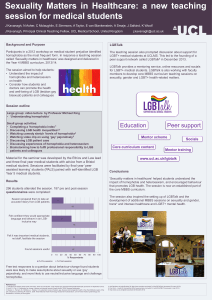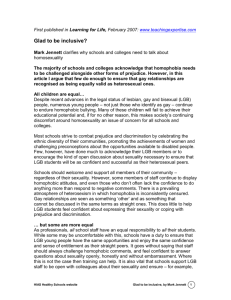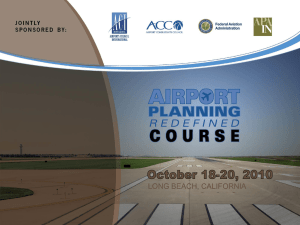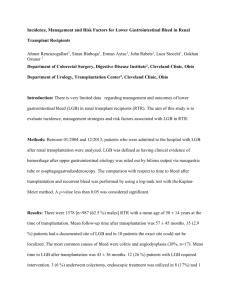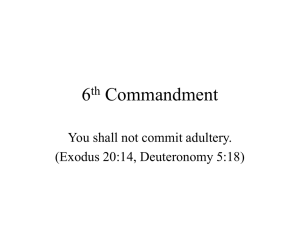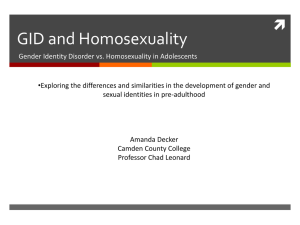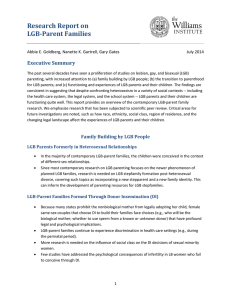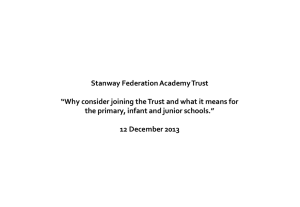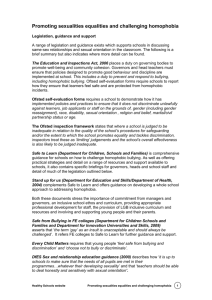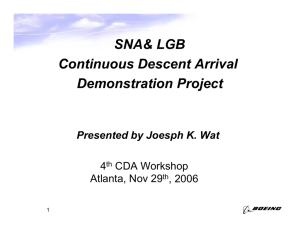Are You Gay? - Royal College of Psychiatrists
advertisement
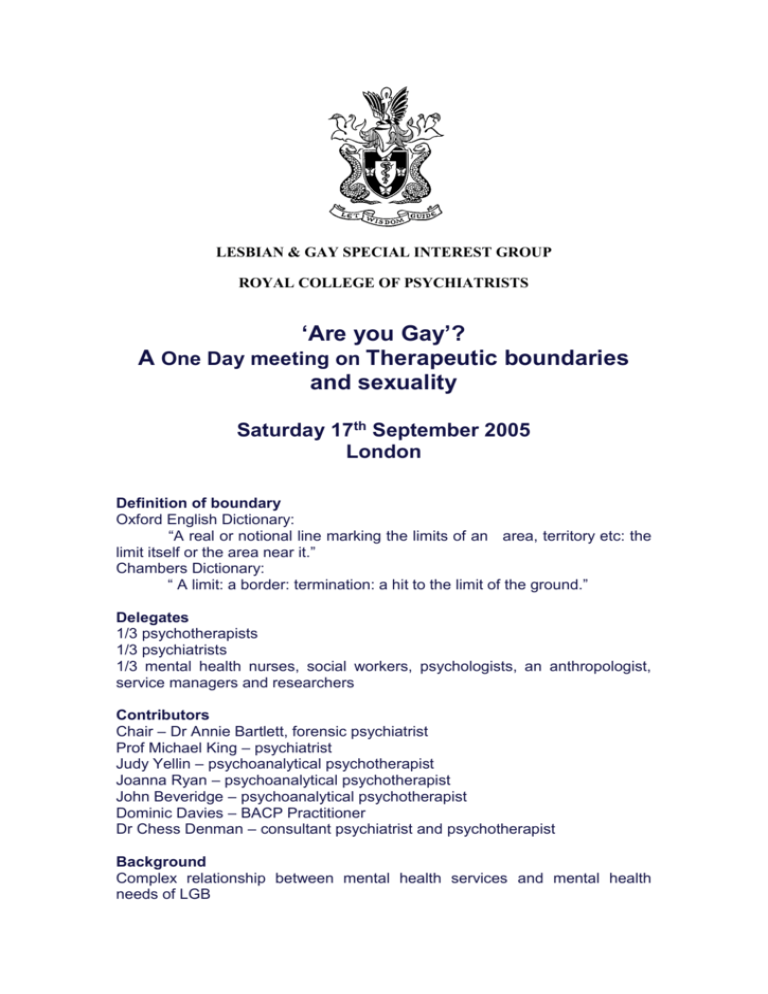
LESBIAN & GAY SPECIAL INTEREST GROUP ROYAL COLLEGE OF PSYCHIATRISTS ‘Are you Gay’? A One Day meeting on Therapeutic boundaries and sexuality Saturday 17th September 2005 London Definition of boundary Oxford English Dictionary: “A real or notional line marking the limits of an area, territory etc: the limit itself or the area near it.” Chambers Dictionary: “ A limit: a border: termination: a hit to the limit of the ground.” Delegates 1/3 psychotherapists 1/3 psychiatrists 1/3 mental health nurses, social workers, psychologists, an anthropologist, service managers and researchers Contributors Chair – Dr Annie Bartlett, forensic psychiatrist Prof Michael King – psychiatrist Judy Yellin – psychoanalytical psychotherapist Joanna Ryan – psychoanalytical psychotherapist John Beveridge – psychoanalytical psychotherapist Dominic Davies – BACP Practitioner Dr Chess Denman – consultant psychiatrist and psychotherapist Background Complex relationship between mental health services and mental health needs of LGB Peculiar history of psychiatry and homosexuality Suspicion on part of LGB population towards psychiatry Discomfort about whether practitioners should be “out” to clients Pathologising homosexuality Homosexuality as a disease: 1952 DSM 1 - sociopathic, not distressed 1968 DSM 2 - non-psychotic sexual deviation 1973 DSM 3 - egodystonic homosexuality 1986 DSM 3R - psychosexual disorder not otherwise specified 1992 ICD 10 - still referred to Treatments Aversion therapy; hormone therapy; behaviourism; social psychoanalysis. Premise – faulty learning and presumed heterosexual “normal” state. 1970’s – increasing visibility through civil rights movement. skills; Mental health problems in LGB Problems with LGB research – definition of sexual orientation, volunteers (self-defined), same sex contact (includes many “false positives”), small numbers in random samples, snowballing sampling, substance abuse higher in gay venues (recruitment sites). Mental health problems in LGB Meta-analysis (475 papers selected, 24 included) Increased prevalence of Suicidal thoughts (pooled OR 1.96, men 1.79, women 4.08) Suicide attempts (pooled OR 2.38, men 6.35, women 1.99) Depression (pooled OR 2.28) Anxiety (pooled OR 1.68) Alcohol dependence (pooled OR 2.27, men 1.46, women 4.17) Drug dependence (pooled OR 2.84, men 2.53, women 3.62) Mental health services and LGB LGB people more likely to seek counselling or psychotherapy than non-LGB Potential minefield: PACE: survey of 274 psychotherapists (1 G, 5 B) Homophobic bias in training. 33% thought LGB therapists needed for LGB clients 24% thought LGB clients’ sexuality central to their problems 10% thought they were successful at resolving clients’ sexuality issues Bartlett, King & Phillips (2001), BJPsych, 179, 545-549. Survey of >1300 psychotherapists (BAP, BPS, UKCP, RCP).: 72% response 17% attempted to change client’s sexuality (within last 5 years) 72% believed LGB clients needed specific service >50% private practice Freud’s three essays on sexuality, 1905 Development of sexuality - not defined at birth but evolves through a freewheeling, independent state unconnected to sexual orientation and gender identity. He believed that homosexuality was an arrested state in this phase but not necessarily one that required “treatment” or resolution. He refused referrals if the only “problem” was homosexuality – there had to be some form of neurosis as well. More negative psychological theories/views on homosexuality Pre-Oedipal fixation (negative Oedipus, regressed, narcissistic object choice). Attribution of generalized psychopathology to an “unevolved” state Biased stance with stereotypical lesbian and gay persona Covert homophobia in therapy room Overt homophobia e.g. fundamental Christian movement in the US “permissible prejudice” Psychotherapists argued against removal of homosexuality from DSM Internalised homophobia Distinction between internalised homophobia and its associated shame/embarrassment and externalised homophobia as a manifestation of repressed homosexuality Client’s internalised homophobia and perceptions/presumptions about therapist/psychiatrist’s opinions interfere with openness in therapeutic relationship Problems in being “out” Labelling – does not allow fluidity in sexuality/orientation Forced binary variables (sexuality and gender) Political pressures in some LGB groups to define oneself. Particularly problematic for transgendered people Recommendations for therapists of LGB people Therapist’s own homophobia has to be explored to be able to offer service Lack of familiarity with homosexual lifestyle is barrier to successful therapy Need for specific LGB psychological/analytic theory and related services that can understand these issues, accommodate the fluidity of sexual orientation and avoid dichotomous identities Coming “out” as a therapist Can increase boundaries due to client’s assumptions when what is needed is elasticity in theory and practice Is it helpful? Depends on individual therapeutic relationship – why do you want to know that? Work with the material rather than creating a dilemma (should I or shouldn’t I disclose?) Why do we need specialist LGB services? Inadequate training in psychotherapy and psychiatry Working with internalised and externalised homophobia Culturally “safer” for clients Fears of seduction Non-specialists can be incompetent in knowledge of homosexual lifestyles and attribute homophobic judgments/acceptance of maladaptive behaviours rather than exploring meaning (e.g. promiscuousness, DSH) or censor material Why don’t we need specialist LGB services? Need loosening of awareness of sexuality i.e. to work with issues in context of theories Problems of labels and binary identities Can block access to resistors – i.e. working with transference around sexuality Fears of seduction Over identification with therapist Collusion with client
